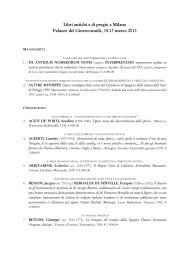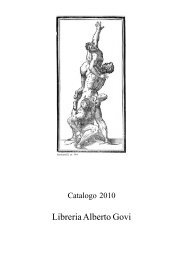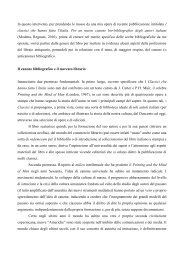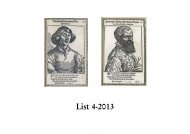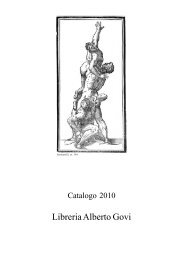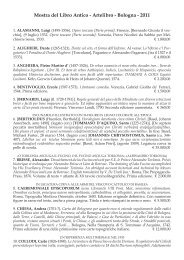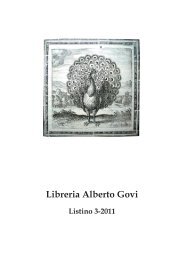to their contemporaries, who were involved in serious, sublimeverse. It found its first peak in the work of Domenico diGiovanni (1404–1448), known as “il Burchiello” (little bark), aFlorentine barber whose shop on the Via Calimala became ameeting place for the city’s wits and literati during the 1420sand 1430s. This barber poet was esteemed by other poets andpatrons alike, so much so that he spawned a group of youngfollowers known as “burchielleschi”. But the culminatingfigure of the burlesque tradition in Italian literature becameFrancesco Berni, who left behind him a considerable schoolof followers, the ‘Bernesque’ poets, also outside of Italy (cf.A. Reynolds, Francesco Berni: Satire and Criticism in the ItalianSixteenth Century, in: “Italian Quarterly” 34/94,1983, pp. 5-15;the same, Francesco Berni: A Survey of Reception over Three Centuries,in: “Altro Polo: Italian Studies in Memory of FrederickMay”, Sidney, 1996, pp. 83-107; and D. Romei, Burleschi, in:“Cinquecento, La cultura non ortodossa nell’Italia del secoloXVI: letteratura, arte, religion”, www.nuovorinascimento.org, 2006, pp. 1-47).“Al pari di certo petrarchismo, anche la produzioneburlesca conosce, inizialmente, una discreta diffusione, graziealle miscellanee, nella fattispecie grazie a quelle approntatedalla stamperia veneziana di Curzio Troiano Navò. La loroprima antologia risale al 1537 e, come recita il frontespizio,essa si riproponeva di accogliere le rime del poeta FrancescoBerni, dell’amico Giovanni Mauro, di monsignor GiovanniDella Casa e di Giovan Francesco Bini. Di ciascun componimento,però, non veniva indicato l’autore, mentre, semprenel frontespizio, i testi erano genericamente definiti, per viadel genere metrico usato, capitoli. Il loro successo editorialedovette essere notevole, visto che, appena un anno dopo, nel1538, la stessa antologia rivedeva la luce, sia pur con qualche ritocco. Lo stampatore, infatti, indicò il nome dell’autoredi ciascun testo e separò materialmente la raccolta in tre sezioni, ciascuna provvista del suo frontespizio ededicata, rispettivamente, alle opere di Francesco Berni, di Giovanni Mauro nonché a quelle di un piccolo gruppodi autori composto da Giovanni della Casa e Giovan Francesco Bini, a cui si aggiungevano un componimento anonimoed uno del pittore Bronzino. Con l’augurio “state sani pur attendendo cose belle”, rivolto ai lettori e posto aconclusione della lettera introduttiva, Curzio segnalava cautamente un possibile seguito editoriale della raccolta,che di fatto arrivò appena un anno più tardi, nel 1539. Qui la novità più rilevante, oltre all’introduzione di opereinedite del Berni, è costituita dall’ampliamento della rosa di poeti burleschi fino ad allora noti e quasi tutti residentia Venezia. Nella Repubblica della Serenissima, i nomi di questi autori, Ludovico Dolce, Benedetto Varchi, Sansedonioe Francesco Maria Molza, erano tanto conosciuti da far pensare che la miscellanea fosse in verità una risposta,tutta veneziana, ai componimenti delle antologie precedenti, le quali raccoglievano testi scritti a Roma tra la finedegli anni ’20 e l’inizio degli anni ’30… In generale, il successo arriso alle varie raccolte Navò fu notevole, tanto chesi contano almeno tre reimpressioni (1540, 1542 e 1545)” (I. Siddi, Una letteratura ‘Da huomini nobili, et da signori’. Lemiscellanee burlesche dei Giunti e dei Navò nel Cinquecento, in. “Idee di letteratura”, a cura di D. Caocci e M. Guglielmi,Rome, 2010, pp. 154-156).a) BERNI, Francesco (ca. 1497-1535). Tutte le opere del Bernia in terza rima, nuovamente con somma diligentiastampate. (Venezia), Curzio Troiano Navò & fratelli, 1538.(55) leaves (lacking the last blank). With a large printer’s device on the title-page and at the end: a rampant lion ona shield hold by two Roman soldiers ‘Fabio’ and ‘Scipion’. Title-page lightly soiled with some marginal repairs nottouching the text, the printer’s device at the end is grossly filled our in brown ink, some light dampstains, a fewentries of ownership, but a good copy.SECOND EDITION. For a time everybody wrote capitoli (prelates, artists, scholars, poets). The most notable exponentof the art was perhaps Francesco Berni (1497-1536), who has given his name to the spirit embodied in thisclass of literature. Berni is one of the most curious figures of the time, and in some respects typical of the forces atwork during the later Renaissance, which, combined with the political conditions, were to bring about the changenoticeable after the middle of the century. For the Petrarchians he had little respect. Unlike his contemporary Molza,who could turn out with equal facility an amatory sonnet and an indecent capitolo, Berni as a rule avoided anydisplay of sentiment, whether real or fictitious. Even when he is serious the reader is never certain that he will notat any moment fly off into a tissue of whimsicalities. His capitolo “In Praise of Aristotle”, containing much saneand sensible eulogy of the philosopher, is addressed to a cardinal’s French cook, and ends with burlesque regretsthat Aristotle had not left a treatise on “roast and boiled, lean and fat”. Yet Berni was more than a flippant cynic.His sincere attachment to such men as Gian Matteo Giberti, the reforming Bishop of Verona, to whom he for a timeacted as secretary, or the grave and pious Pietro Carnesecchi, shows that he could appreciate goodness; while thescathing sonnet, couched in a tone of unwonted ferocity, which he hurled at Pietro Aretino, at a time when that in-- 20 -
famous personage was in high favor with powerful princes, proves that in the matter of cynicism he was preparedto draw a line. His words on Michelangelo, already quoted (which, curiously enough, he uses also of Aristotle), areevidence that he could respect seriousness in others; and he had a vein of it in himself. For the work by which heis perhaps, or for long was, best known, the rifacimento, or recasting, of Boiardo’s Orlando Innamorato into a stylemore congenial to the fastidious taste of the Cinquecento, he wrote (about 1530) some stanzas, couched, in spite ofa few outbreaks of his usual mirthfulness, in what seems a tone of genuine piety. Though we cannot, with Vergerio,regard the lines as evidence of anything in the nature of “conversion” on Berni’s part, or, in spite of the phrase “Lutheranmeans good Christian”, of any definite adhesion to Protestant views, they show that he had moods in whichhe regretted the lack of practical religion in Italy, and hoped for better things (cf. S. Longhi, Lusus. Il capitolo burlesconel Cinquecento, Padova, 1983, passim; and the same, Le rime di Francesco Berni. Cronologia e strutture del linguaggioburlesco, in: “Studi di filologia italiana“ 34, 1976, pp. 249-299).Only a few of Berni’s works were published during his lifetime. After his death, however, many of hiscompositions were published, often together with those of his imitators (Sonetti, Ferrara, Scipione e fratelli, 1537; Icapitoli del Mauro e del Bernia, Venezia, Navò, 1537; Le terze rime del Bernia e del Mauro, Venezia, Navò, 1537, a variantof the preceeding edition; Tutte le opere del Bernia in terza rima, Venezia, Navò, 1538; cf. Poeti del Cinquecento, M. Danzi,G. Gorni & S. Longhi, eds., Milan & Naples, 2001, I, pp. 633-634). The lay magistracy dedicated to suppressingblasphemy, the ‘Esecutori contro la Bestemmia’ (a submission of the Council of Ten, created in 1537) confiscatedin 1546 all of Berni’s works printed by Navò and his whole oeuvre was put on the Roman Index in 1559 (cf. J.M.de Bujanda & al., eds., Index de Rome: 1557, 1559, 1564. Les premiers index romains et l’index du Concile de Trente, Sherbrooke,1990, p. 272).Between 1548 and 1555 Anton Francesco Grazzini, called Il Lasca (1504-1584), a bernesque poet himself,published the by then most comprehensive corpus of burlesque poetry, Il primo [-secondo] libro delle opere burleschedi M. Francesco Berni, di M. Gio. della Casa, del Varchi, del Mauro, di M. Bino, del Molza, del Dolce, e del Firenzuola (cf.R.J. Rodini, Antonfrancesco Grazzini. Poet, Dramatist and Novelliere, 1503-1584, London, 1970, p. XII; and A. Reynolds,Francesco Berni e Anton Francesco Grazzini, in: “Critica letteraria”, 9, 1981, pp. 453-464).Berni was born in Lamporecchio, Tuscany, in Bibbiena (a district in the upper Arno), from noble yet poorsurroundings. At twenty better luck awaited him in Rome, where Cardinal Bibbiena, his relative the Cardinal’snephew, Angelo Dovizi, and Giovanni Mattia Giberti, Bisop of Verona and Datary to Pope Leo X, successivelyemployed him. In the datary, however, he had found a hard taskmaster, who kept him at his correspondence allday long and would not countenance the buffooneries in which the young clerk took huge delight. So, in 1531 wefind Berni at Padua in rapturous freedom, gaily bent on bandying insults with the notorious Pietro Aretino. Still,the autumn of the same year saw him back at his desk in the episcopal residence of Verona, penning letters witha reluctant hand. Not until 1533, when Cardinal Ippolito dei Medici, who had engaged him the year before, madehim a canon of the Florentine cathedral, did he find a position that pleased him. But that long dreamed of life, withits unbridled frolic and happay idleness, was not to last, for, becoming involved in the feud then raging betweenIppolito and Alessandro dei Medici, he fell victim to poison under very mysterious circumstances two years afterwards.Berni’s most extensive work, the refashioning of Matteo Maria Boiardo’s chivalric poem, L’Orlando innamorato,was published at Milan seven years after his death (cf. G. Giampieri, Francesco Berni, Fucecchio, 1997, passim).Edit 16, CNCE5535; Index Aureliensis, 117.692; D. Romei, op. cit., p. 2, TR38.(bound with:)b) DELLA CASA, Giovanni (1503-1556) - BINI, Giovanni Francesco (ca. 1484-1556). Le terze rime deMesser Giovanni Dalla Casa di Messer Bino et d’altri. (Venezia), Curzio Troiano Navò & fratelli, 1538.(36) leaves. With a large printer’s device on the title-page and at the end: a rampant lion on a shield hold by twoRoman soldiers ‘Fabio’ and ‘Scipion’. The printer’s device at the end is grossly filled out in brown ink, some lightdampstains, a very good copy.SECOND EDITION of the burlesque verses of Della Casa and Bini. The volume also includes an anonymous composition,Capitolo del ravanel and the first known publication by the painter Agnolo Bronzino (1503-1593), Capitolodel pennello (cf. D. Parker, Bronzino. Renaissance Painter as Poet, Cambridge, pp. 24-28). Two composition attributedto della Casa, Il Forno and Il Bacio, are printed here for the first time (cf. A. Corsaro, Giovanni della Casa, poeta comico,in: “Per Giovanni della Casa: richerche e contributi. Gargano del Garda, 3-5 ottobre 1996”, G. Barbarisi & C. Berra,eds., Bologna, 1997, pp. 123-173).Giovanni della Casa, born into a rich Florentine family, spent his formative years in Bologna where hestudied law and especially literature, becoming part of a literary circle that included Pietro Bembo and LodovicoBeccadelli, with whom he went to Padua in order to complete his humanistic education by learning Greek. After1532 Della Casa settled in Rome and began an ecclesiastical and diplomatic career under the protection of CardinalAlessandro Farnese (later Pope Paul III). He became clerk to the Apostolic Chamber, papal emissary to Florence,archbishop of Benevento and papal nuncio to Venice (in this charge he was responsible for the compilation of theIndex of 1549). After the accession of Julius III to the papacy in 1551, Della Casa retired to Venice and occupied himselfwith his writing. He was recalled to Rome in 1555 by Pope Paul IV, who made him secretary of state to the Vatican,but he failed to obtain a desired cardinalship before his death a year later. His most successful work was thefamous Galateo (1558), a treatise on manners (cf. A. Santosuosso, Vita di Giovanni Della Casa, Roma, 1979, passim).Giovanni Francesco Bini, a native of Florence, was assistant to Jacopo Sadoleto in the Segreteria dei Brevi,and later became his successor in that position. He also was canon of Santa Maria Maggiore. Like his fellow accademicianBerni, he was a member in the Roman Accademia dei Vignaiuoli (cf. G. Ballistreri, Giovanni Francesco Bini,in: “Dizionario biografico degli italiani”, 10, Roma, 1968, pp. 510-13). Among the seven ‘capitoli’ in the volume the- 21 -
- Page 1 and 2: Catalogue 2013Libreria Alberto Govi
- Page 3 and 4: Catalogue 2013Libreria Alberto Govi
- Page 5 and 6: an hitherto unknown philosophical m
- Page 7 and 8: ustica Lib. X., edited by Giorgio M
- Page 9 and 10: the end is furthermore printed the
- Page 11 and 12: without typographical data, but pro
- Page 13 and 14: Letteratura Italiana”, CXL, 1963,
- Page 15 and 16: as secondary only.The present two e
- Page 17 and 18: position as secretary at the court
- Page 19: From 1528 he was rector of the newl
- Page 23 and 24: Luigi Alamanni and Antonio Brucioli
- Page 25 and 26: In Pincio’s biography of Bernardo
- Page 27 and 28: Tempio della Fama; e così ne trass
- Page 29 and 30: power, and yet to make it possible
- Page 31 and 32: lini, Andrea Alciati, Lilio Gregori
- Page 33 and 34: phy in particular, was presented as
- Page 35 and 36: quale quello che lui auspicava, e l
- Page 37 and 38: After the flight of the Medici from
- Page 39 and 40: to learn from their own experience
- Page 41 and 42: with some manuscript compositions p
- Page 43 and 44: death sentence issued against him o
- Page 45 and 46: the key work to Della Casa’s thou
- Page 47 and 48: important ones along with those of
- Page 49 and 50: a heavily annotated copy44) HORATIU
- Page 51 and 52: solitudine (1545), but undoubtedly
- Page 53 and 54: provide less description of patholo
- Page 55 and 56: the most up-to-date scientific ency
- Page 57 and 58: (pp. 4-10) written by the author hi
- Page 59 and 60: successivi alla consapevolezza che
- Page 61 and 62: night [February 22]. Rarely does a
- Page 63 and 64: subjects, including Saint-Gelais’
- Page 65 and 66: Catherine de’ Medici, succeeded o
- Page 67 and 68: losofico ed allegorico delle Metamo
- Page 69 and 70: The act concerning primogeniture is
- Page 71 and 72:
are not many in number but who are
- Page 73 and 74:
the Camilletta, his first work, Gut
- Page 75 and 76:
selig, sich nit allein zu kunst geg
- Page 77 and 78:
dle, or low. There are, however, pr
- Page 79 and 80:
nity: ‘mercenaries should be done
- Page 81 and 82:
colò Sfondrati), to whom the Causa
- Page 83 and 84:
close of Semiramis’ career. Ninus
- Page 85 and 86:
e contenuti matematici in Henri de
- Page 87 and 88:
The first Hungarian dictionary - Cr
- Page 89 and 90:
& T. Kovács, Deutschlernen in den
- Page 91 and 92:
chitectura’ des Wenzel Dietterlin
- Page 93 and 94:
neo-Latin anthology devoted exclusi
- Page 95 and 96:
as De la puissance ecclésiastique
- Page 97 and 98:
colazione was not eaten first thing
- Page 99 and 100:
advanced both the technical and the
- Page 101 and 102:
di Giorgio Zorzi, ambasciatore in O
- Page 103 and 104:
the Misnah100) MISNAYOT MESUDAR NAS
- Page 105 and 106:
the task of taking part to the nego
- Page 107 and 108:
This is the only iconological work
- Page 109 and 110:
on that occasion, were described an
- Page 111 and 112:
millo Camilliani, Francesco’s son
- Page 113 and 114:
Blanchard, Correggio and Mignard, R
- Page 115 and 116:
di Cicerone d’ottime antiche stam
- Page 117 and 118:
Pietro Aretino125) MAZZUCHELLI, Gio
- Page 119 and 120:
music129) TESTORI, Carlo Giovanni (
- Page 121 and 122:
Vol. VIII (1773): pp. (6), 854 with
- Page 123 and 124:
Di Felice e Gregorio Fontana, 1905,
- Page 125 and 126:
Cicognara, no. 190 (“Nelle quattr
- Page 127 and 128:
mo: fonti, theorie, modelli, 1750-1
- Page 129 and 130:
commentary on the treaty on shabbat
- Page 131 and 132:
poet laureate of Austria, and he le
- Page 133 and 134:
geo-political situation of the regi
- Page 135 and 136:
ope collecting views and pictures o
- Page 137 and 138:
inc.), 100 numbered engraved plates
- Page 139 and 140:
a gift from Emperor Napoléon III t
- Page 141 and 142:
Ardène, no. 123Caprara, no. 103 Tr
- Page 143 and 144:
Speckle, no. 73 Besson, no. 60- 143



